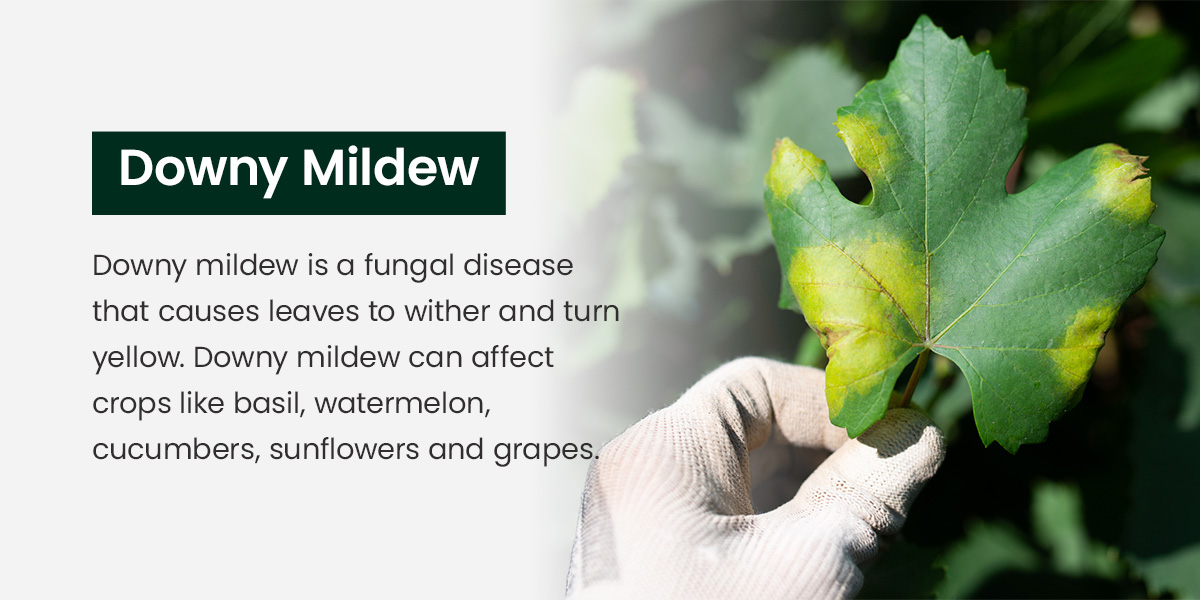
You work hard to produce quality crops for your community, but diseased plants can affect your livelihood and food stock. By understanding different plant diseases, you can spot signs of infection, treat symptoms and prevent the spread. Here’s how to identify and control these conditions for healthy growth.
How Do You Identify a Plant Disease?
Identifying plant diseases requires knowing what symptoms to look for. Infections can affect a plant’s growth, function, color and appearance. When you see the warning signs, you can intervene early and treat plants effectively.
If you notice signs of disease, you can also take samples of affected areas and send them to a local university or treatment center for lab testing and diagnosis.
Common Plant Diseases
You can take preventive measures once you know how to identify various plant diseases. Here are some to look for.
1. Anthracnose
Anthracnose is a fungal disease that affects plants, trees, fruits and vegetables. It can cause physical symptoms like dark sunken lesions on leaves, flowers, fruits and stems. The fast-spreading fungus also affects developing shoots and leaves.
Fungus on plants, vegetables, fruits and trees is one of the leading causes of anthracnose. This plant disease can proliferate in warm and humid conditions and spread by watering. Anthracnose can affect whole vegetables and kill twigs on trees.
Common signs of anthracnose include:
- Small yellow or brown dots on leaves
- Dark spots and pink spore masses on fruits
Here are some tips for treating anthracnose plant disease:
- Remove and dispose of affected plants.
- Prune dead wood on trees and dispose of infected leaves.
- Spray plants with a copper-based fungicide.
2. Blossom-End Rot
Blossom-end rot is a calcium deficiency in plants and crops that breaks down the blossom or bottom end of fruiting crops like tomatoes, squash and eggplant.
Problems that lead to this issue include:
- Over- or underwatering soil
- Imbalanced soil pH
- High sodium levels
- Plant root damage
- Excessive nitrogen-heavy fertilizer
You can identify blossom-end rot by looking for dark, sunken spots on the bottoms of green, ripening fruits or hollow black or brown bruises that spread to half the fruit.
Take the following steps to treat affected areas and prevent blossom-end rot from spreading to other developing crops:
- Trim damaged fruit areas.
- Test your soil’s calcium.
- Frequently check your soil pH.
- Stalk plants while they are developing.
- Plant calcium-tolerant vegetable cultivators.
- Add mulch to retain moisture in dry seasons.
- Avoid overfertilizing soil and use a calcium-dense fertilizer.
- Water plants consistently and avoid underwatering and overwatering.
3. Downy Mildew
Downy mildew is a fungal disease that causes leaves to wither and turn yellow. It can kill leaves but does not affect the plant stems and petioles. Downy mildew can affect crops like basil, watermelon, cucumbers, sunflowers and grapes. This fungus can thrive and spread in humid and warm climates, causing severe crop reduction.
Signs of downy mildew include:
- Yellowing and molding in leaves
- Gray spores on the underside of leaves
- Yellow mosaic pattern on the upper leaf surface
- Infected areas turning brown
Try these downy mildew treatments:
- Remove and dispose of infected plants.
- Trim and dispose of infected areas.
- Prune lower leaves to increase air circulation.
- Sanitize shears with bleach or alcohol to prevent the spread.
- Keep plants dry.
- Keep leaves off the ground.
- Water plants with a drip-line irrigation system.
- Add mulch to keep the soil moist.
4. Early Blight
Early blight is a fungal disease that affects tomatoes, potatoes, eggplants and peppers. Rapidly spreading fungal pathogens cause early blight. Wet, humid and rainy conditions like morning dew create the ideal environment for early blight to proliferate.
Since it’s easy to confuse early blight with septoria and bacterial leaf spot disease, it’s essential to know what symptoms to look for. Signs of early blight can include:
- Quarter-inch to half-inch brown spots
- Oval spots on stems and damaged fruit near the stem
- Dark brown rings on leaves and yellow leaf tissue around the brown spots
Early bright can be challenging to cure, and cultural methods can be the best solution.
- Remove and dispose of infected plant areas as early as possible.
- Cultivate more tolerant plant variants.
- Use fertile soil.
- Irrigate from below and avoid overhead systems.
- Add mulch to the soil and reduce soil splash.
5. Mosaic Viruses
Mosaic viruses commonly affect crops like tomatoes, cucumbers and squash, causing yellow, white and dark green spots and streaks on the leaves. Common signs of mosaic viruses include:
- Blister-like yellow and white molted leaves
- Stunted plant growth and leaf deformities
Preventing mosaic viruses is vital, as they can be challenging to cure. You can minimize mosaic virus plant damage with these treatments:
- Remove and burn or throw out infected plant areas.
- Sanitize gardening tools with light bleaches to minimize the spread.
- Monitor surrounding plants.
6. Powdery Mildew
Powdery mildew is a white fungal disease affecting plants like squash, melons, tomatoes, roses and legumes. Powdery mildew can form on top of infected leaves. The white mildew spores spread to other plants in the wind. Powdery mildew can stunt plant growth and reduce fruit yield and quality. It thrives in warm, dry and humid climates and primarily affects plants in shady areas.
Signs of powdery mildew can include:
- Dusty white leaves
- White circular spots
- Mildew on the upper part of leaves
- Disfigured leaves and buds
If your plants become infected, your best option is to prevent the spread. You can use fungicides to help prevent mildew growth.
Treat powdery mildew by:
- Removing and safely disposing of infected plant areas like stems and fruit
- Never composting infected plants
7. Rust Plant Disease
Rust disease is a fungus that thrives in mild, moist climates, affecting plant health, strength and flower production. Rust disease spores can spread by wind or water and infect other plants.
Rust plant disease may resemble metal corrosion. Warning signs can include:
- Yellow or white upper leaf spots.
- Red or orange blisters underneath leaves.
- Spores forming in spots and leaf distortion.
Rust plant disease treatment
- Remove and destroy infected plant areas
- Avoid splashing water plants to prevent the spread
- Clean dirt in between plants.
8. White Mold
White mold is a fungal disease affecting numerous plant types like lettuce, beans and peas. White mold fungus can develop in spring and summer and spread to other plants by the wind in cool conditions. Signs of white mold can include:
- White-soaked stems
- Wilting stems with tan or dark lesions
How to treat white mold:
- Remove affected plants.
- Use mulch or plastic to cover the infected ground and prevent spread.
- Replace infected soil with clean soil.
Control Plant Disease With CropCare® Equipment
Knowing how to treat plant diseases is vital for protecting your plant and crop quality. CropCare® provides high-quality agricultural sprayers and equipment to help you keep your farm or garden healthy and thriving. With our three-point boom sprayers, you can prevent funguses and other plant infections from proliferating. To get started with CropCare®, find a dealer near you or contact us today.



